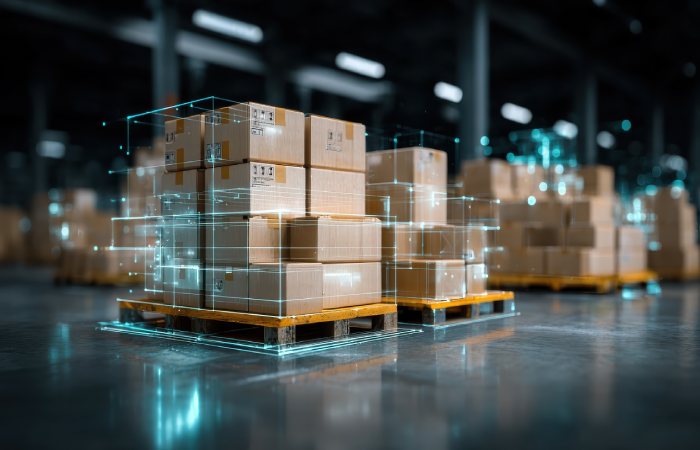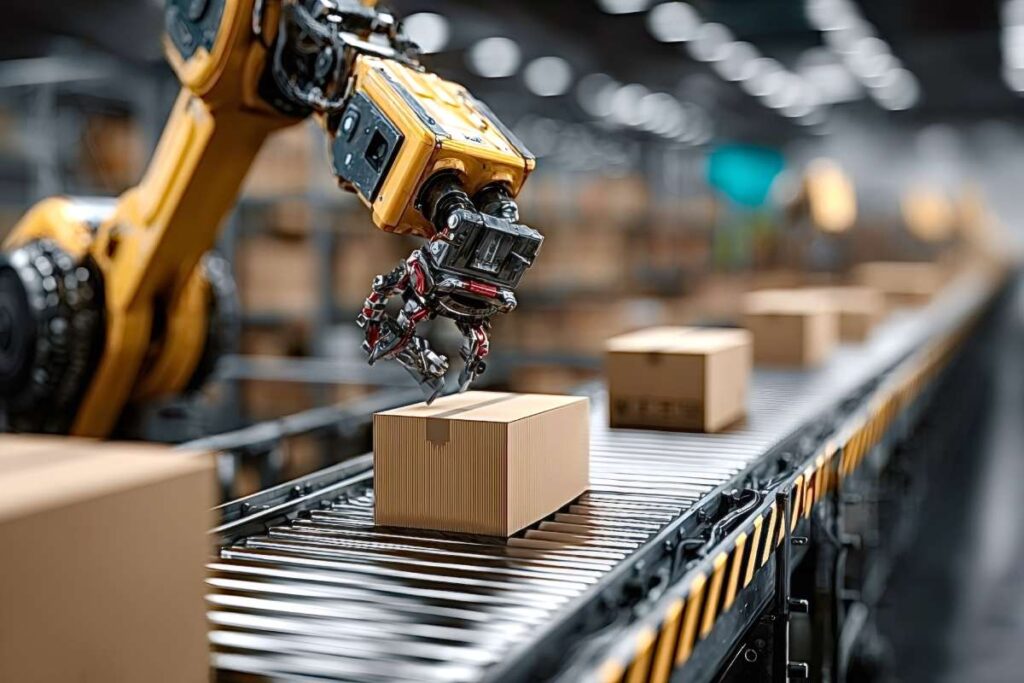Warehouse automation has evolved rapidly over the past decade, reshaping fulfillment and material flow through speed and precision. But in its traditional form, automation follows fixed rules and predefined paths. It excels at repetition but falters when faced with complexity or unpredictability. The introduction of artificial intelligence changes that.
AI enables warehouse systems to think contextually, make dynamic decisions, and continuously adapt to real-time conditions. Rather than merely moving products faster, AI transforms how facilities orchestrate labor, equipment, and data. This shift accelerates throughput, elevates operational intelligence, and unlocks a future where facilities become learning environments.
Table of Contents
Beyond Speed: AI Enables Contextual Decision-Making
Traditional automation executes tasks efficiently but without understanding the broader context. AI introduces nuance. With contextual decision-making capabilities, AI-powered systems can reprioritize orders based on delivery urgency, adjust routing to avoid congestion, or flag at-risk SKUs for quality checks.
This intelligence adds a layer of orchestration that transforms automation from mechanical execution into a responsive, situational system. These capabilities enhance responsiveness across high-SKU, high-velocity operations, aligning real-time logistics with actual business goals.
Warehouse automation logistics continues to evolve through AI integration, reshaping productivity models across retail, grocery, and fashion networks. What was once linear and rigid is now dynamic and iterative, with AI enabling the adaptation of picking strategies, reprioritization of dock assignments, and synchronization of outbound waves based on real-time demand. This responsiveness is particularly transformative in high-velocity environments, where delays or errors can quickly ripple downstream. By embedding intelligence into every layer of automation—from shuttle control to inventory staging—AI makes warehouse operations more resilient, responsive, and performance-driven.
The Strategic Value of Predictive Operations
AI shines brightest in its ability to anticipate and act. By analyzing historical trends and real-time data inputs, AI systems forecast demand spikes, predict stockouts, and dynamically allocate labor.
This predictive capability enables operators to preempt disruptions, proactively shift resources, and better manage seasonal or daily variability. Whether adjusting labor schedules or optimizing replenishment cycles, AI transforms static planning into adaptive execution.
Facilities that leverage predictive AI reduce overstaffing, minimize missed SLAs, and improve planning precision across the board. This anticipatory edge not only enhances service consistency but also enables tighter coordination with upstream partners and downstream delivery teams.
AI’s Role in Order Flow Optimization
In fast-paced fulfillment centers, order flow optimization is a critical performance lever. AI algorithms dynamically sequence picks, balance zones, and batch orders based on proximity, priority, and handling constraints.
This real-time intelligence minimizes travel distances and reduces congestion across picking zones and conveyor networks. It also improves the coordination of subsystems, such as automated sorters, shuttles, and packing lines.
As order profiles change throughout the day, AI-driven systems continually refine their logic, keeping workflows aligned with fulfillment targets and capacity thresholds. Over time, these continuous refinements build into a self-optimizing engine that preserves throughput while reducing friction.
When AI Meets Warehouse Software
The benefits of AI are amplified when embedded within the software layer that manages warehouse operations. Intelligent warehouse management software serves as the facility’s nervous system, absorbing data from machines, sensors, and user actions to inform real-time decision-making.
This integration allows for adaptive slotting, intelligent wave release, and rule-based exception handling. In multi-channel or multi-client environments, AI-guided systems can shift workflows dynamically based on order mix, fulfillment channel, or inventory location.
AI-enhanced warehouse management software increases agility, reduces manual intervention, and unlocks higher throughput without expanding the system footprint. It also empowers control room teams with intuitive visualizations that flag anomalies before they cascade. Middleware and APIs allow AI systems to ingest external data—weather forecasts, transit delays, carrier capacity—and reoptimize warehouse operations accordingly.
That said, AI performance is only as strong as the quality of its data. Poorly integrated systems, incomplete datasets, or skewed training models can undermine decision-making and reinforce operational blind spots. Human override controls and continuous retraining loops remain critical in high-stakes environments.
Industry-Specific Intelligence
AI’s value is compounded when tailored to the unique demands of specific verticals. In fashion, AI can prioritize SKUs with high return likelihood or account for size/color variability in packing logic. In grocery logistics, it can optimize for freshness, temperature sensitivity, and expiration dates.
Generic AI models often fail to deliver value in these environments because they lack industry-specific training data. By building models around sector-specific variables, operators gain more accurate forecasts, smarter exception handling, and improved customer outcomes.
Industry-focused logistics, paired with AI, allow operators to meet sector benchmarks while maintaining flexibility in high-change environments. For instance, in apparel logistics, AI models trained on seasonality trends and SKU lifecycle data can preemptively adjust buffer stock allocations, optimize carrier selection based on promotional calendars, and automate return routing by analyzing product condition and location. In cold chain logistics, AI can modulate picking strategies based on product shelf life, temperature zones, and last-mile delivery timelines. This level of specificity enables supply chains to respond in real time to volatility while preserving industry-defined service standards and minimizing operational waste.
Safety, Energy, and Sustainability Benefits
AI enhances more than throughput. Its contribution to safety and sustainability is increasingly evident in energy-aware routing, predictive equipment diagnostics, and dynamic traffic control.
By reducing deadhead travel and optimizing equipment usage, AI reduces kilowatt-hour consumption per order. It also increases facility safety by adjusting AMR and conveyor logic to avoid high-traffic areas during peak human activity.
Some systems use computer vision to detect unsafe conditions and issue automated slow-down protocols, while others adjust lighting and HVAC loads based on zone occupancy. In ESG-conscious environments, AI-supported systems provide measurable gains in energy reduction, emissions tracking, and workplace safety—a trifecta increasingly critical to long-term operational success.
AI at the Human-Machine Interface

AI is also reshaping how operators interact with automation systems. Through natural language interfaces, predictive dashboards, and real-time decision support, warehouse teams gain clearer insights into system performance and exception handling.
Instead of manually tuning rules, supervisors can approve AI-driven recommendations for pick sequencing, trailer loading, or replenishment scheduling. This shift lowers the technical threshold for human decision-makers and improves reaction time during peak windows.
These interfaces are increasingly designed with inclusion in mind—multi-language support, accessibility for varied physical needs, and adaptive visual displays that highlight critical actions for both seasoned and temporary staff. In high-turnover operations, these systems simplify training, reduce cognitive overload, and maintain consistent performance.
The Road Ahead: AI as a Force Multiplier
Unlike fixed automation, AI becomes more powerful over time. Every cycle, every exception, and every delay provides learning data that sharpens future decisions. This compounding effect transforms static systems into continuously improving assets.
Operators investing in AI are not simply adding a tool; they’re futureproofing. As SKU counts climb, order variability increases, and labor markets tighten, AI becomes the backbone of adaptive warehouse strategy.
Warehouse Automation has entered a new phase in which software intelligence rivals mechanical performance in terms of impact. AI-driven orchestration improves KPIs like order accuracy, dock-to-stock cycle time, labor utilization rates, and asset uptime. These gains drive strategic ROI that compounds quarterly and directly aligns with executive objectives around operational resilience and shareholder value.
Intelligence Is the New Infrastructure
As warehouses grow more complex, the need for intelligent orchestration increases. Machinery still matters, but intelligence defines the system’s effectiveness.
AI enables facilities to operate with less friction, more resilience, and greater foresight. It doesn’t replace human expertise but enhances it, turning decision support into a strategic advantage.
Those who embed AI into their automation stack today will be the ones setting tomorrow’s standards for fulfillment performance—both inside the warehouse and across the broader supply chain.

